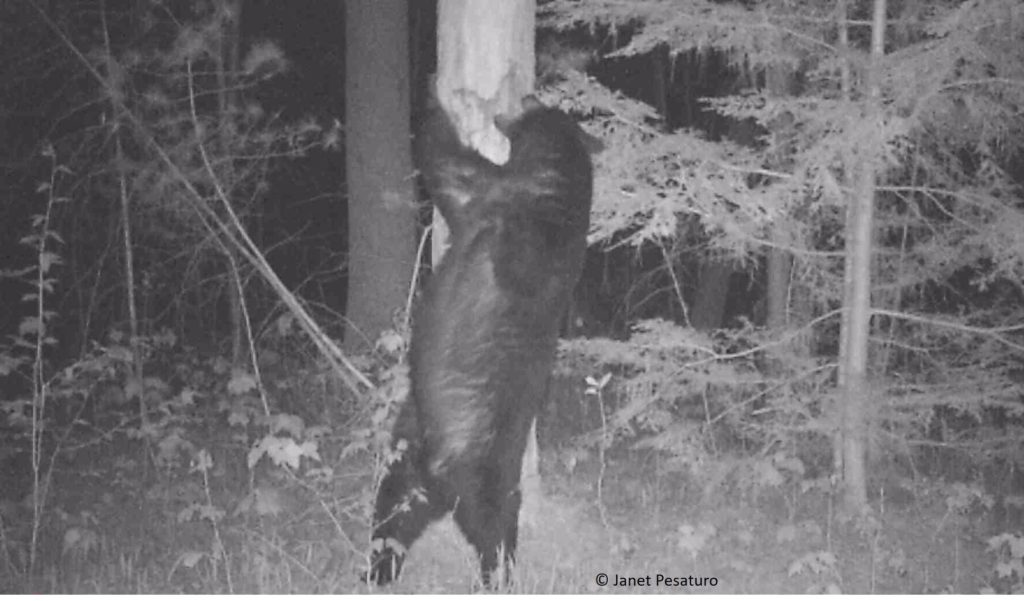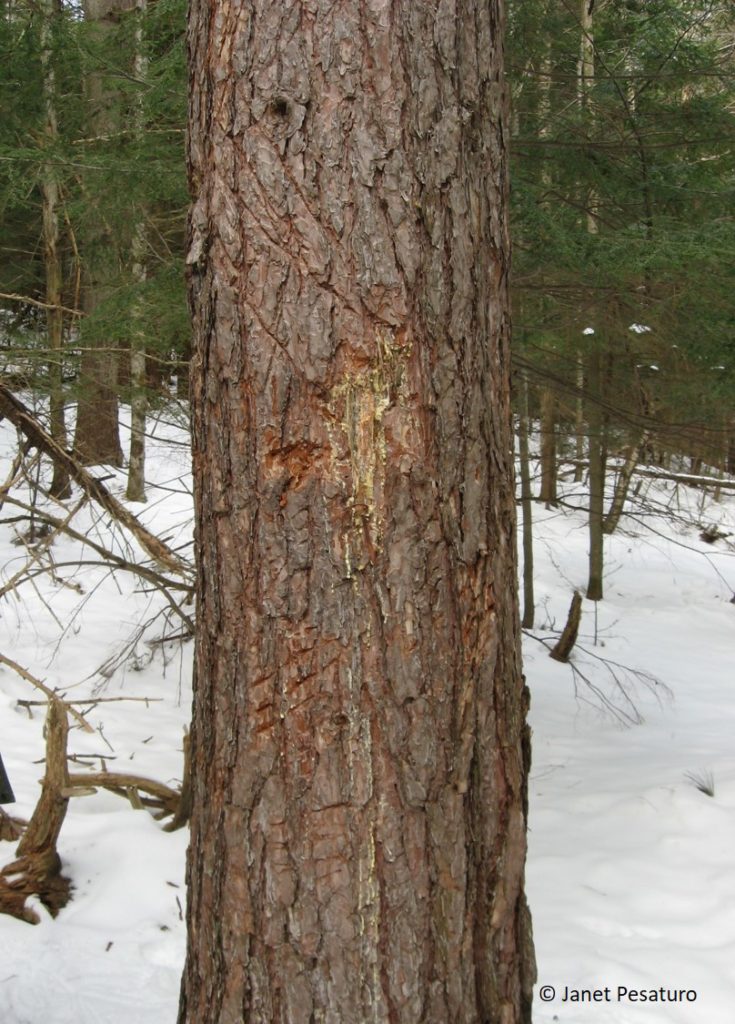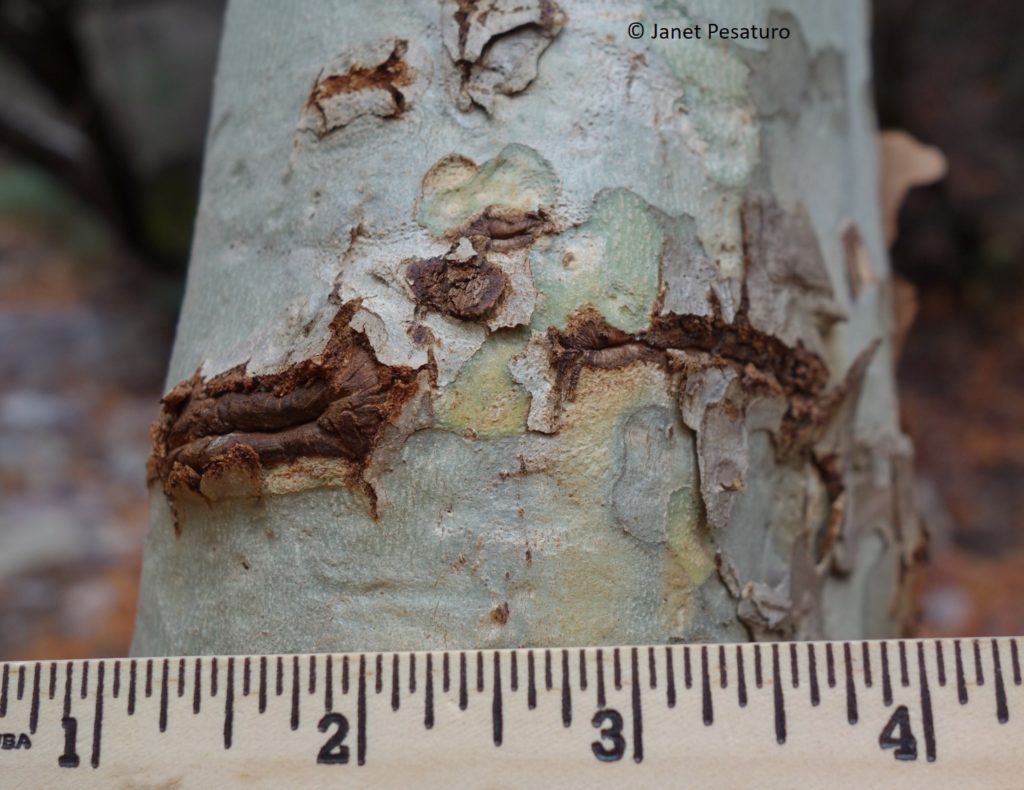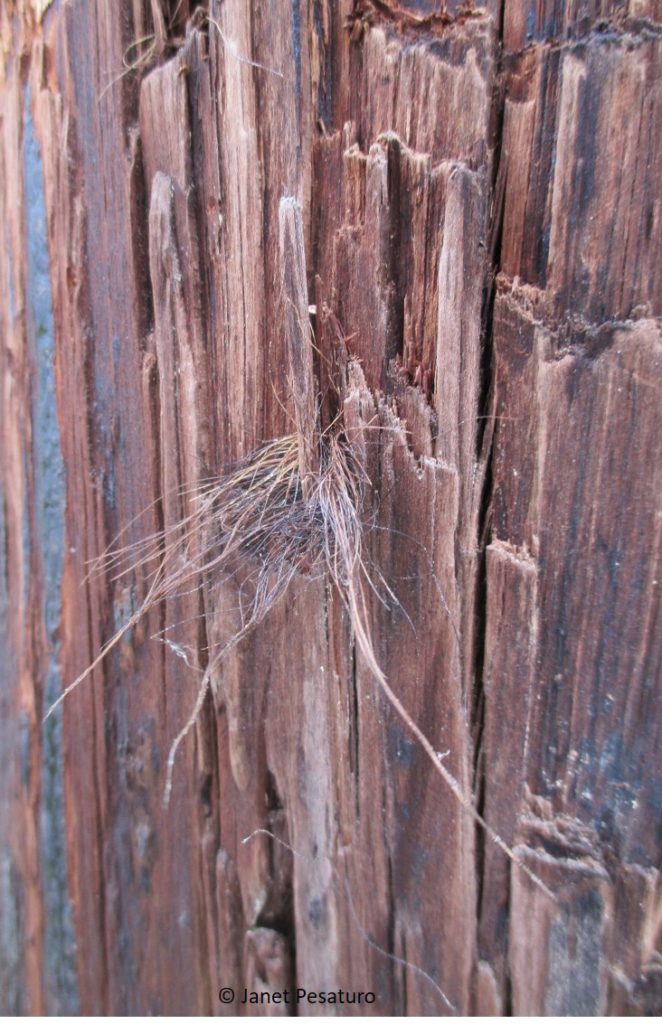Black Bear Mark Tree – Video

A black bear biting a mark tree in Massachusetts. In this case, it is a red pine, a commonly used tree species in the northeastern US. Notice how he reaches around and claws with his front paw as he bites.
Black bears visit certain “mark trees” that they bite, rub, and claw presumably for the purpose of communication with other bears. Multiple bears may visit the same tree repeatedly, resulting in an abundance of accumulated sign. Males mark mostly in spring and summer – before and during the mating season – perhaps to stake claim on females. Females mark mostly in late summer and early fall, perhaps to defend important food sources needed to fatten up for winter hibernation. However, even immature bears will stop at these trees for a rub and a bite when passing through.
The video below shows highlights of bear action at a single mark tree in Massachusetts last year. The camera was targeting the tree spring through late summer (though I switched from an Exodus to a Reconyx part way through). At least 2, and probably 4, different bears stopped to mark. I believe there were two different adult males and two juveniles. The adult males marked, in this case, May through July, and the juveniles marked only in July and August.
In my experience so far, black bear mark trees are most often found along well-used travel routes, usually near large wetlands and along streams, though other trackers say they can be found along any bear run, even on ridge tops.
The tree species and size may be important. In the northeastern US, black bears seem to prefer large red pines (Pinus resinosa), though I found a small (5-6 inch diameter) red pine mark tree in Massachusetts. Favored tree species may vary geographically. In Arizona, I found an Arizona sycamore (Platanus wrightii) used as a mark tree, and this one was only 3 inches in diameter. In any area, bears use utility poles, sign posts, and other human structures as mark “trees”.

This red pine in Vermont is used by black bears as a mark tree. Note the abundant sign of rubbing, biting, and clawing. Most of it appears around eye level or a little lower.

An old, scarred bite mark on a small Arizona sycamore used as a mark tree. One of those brown dashes was made by an upper canine, and the other was made by a lower canine.
Not every tree with a bear bite mark or claw marks is a “mark tree”. Look within 2-6 feet above ground for sign of repeated use: multiple bite marks, multiple sets of claw marks, and sign of rubbing. The rubbed area may appear smoothed due to bark flaking off, and there may be hairs stuck to the tree. Beware the sun can bleach the hair within a few months, so don’t assume blonde hair is not bear hair.

Black bear hairs stuck to a utility pole used as a mark “tree”. Notice that most of the hair has been bleached by the sun.
A tree with only claw marks created by a climbing bear is not a mark tree. Bears climb trees to escape danger, to play, and to forage for food in the canopy.

I love the video of the cub rubbing the tree after the adult was finished- would you consider that modeling? Also, that’s the first video I’ve seen if a bear biting while facing a tree- cool stuff! Why does a bear bite a tree that’s not a mark tree? Did you mean it may bite it when it climbs up to look for food or whatever ?
All of those clips were separated by days or weeks, so I don’t know if the juveniles learn by watching adults, or if they are naturally drawn to rubbing and biting a tree that already carries the scent of other bears.
Good question about bear biting on a tree that isn’t a mark tree. I thought about this as I wrote the post and was deliberately vague/incomplete. The answer is that I don’t know why they do it, but I have seen trees with a single bite and no claw marks or clear sign of rubbing. I’m (somewhat arbitrarily) choosing not to call them “mark trees” because they don’t have sign of repeated marking. Maybe some of those trees do become mark trees (used repeatedly).
Excellent video, congratulations on getting the bears marking that tree. Down here in PA where red pine are few and far between they seem to prefer either hemlock or pitch pine, whichever is available. Male bears also seem to break off or otherwise destroy small conifers during mating season, sometimes bite marks are visible, in other cases they seem to use their front feet to break the tree.
Oh that is cool – I have never seen hemlock or pitch pine used as mark trees up here. Fascinating to compare regional variations. Yes, bears decapitate or beat up small conifers here, too.
https://www.docjones.de/wirkstoffe/kiefer
We love this video :-), maybe they prefer this trees ’cause of the medical effect 🙂
Greeetings from Germany
Haha. Maybe, but they sure don’t look like they’re in need of medicine. 🙂
Pingback:Black Bear Straddle Marking - Winterberry Wildlife
Pingback:Targeting Unique Habitat Features with Trail Camera - Winterberry Wildlife
Pingback:Bobcat Scratching Posts and Logs - Winterberry Wildlife
Hey ex-neighbors,
I was hiking at 8,000 ft in Colorado and ran across an aspen that had rather heavy bear claw scars. I took a photo to remind me to look it up when I got home. Your site was the first to pop up when I googled the topic. Small world! The tree was on a heavily used trail near a water source that is also used by cows. Looking at my photo, I can’t distinguish bite marks or rubbing but it’s a heavily scarred tree. I’m thinking that it is simply a convenient place to avoid people and cows since the scaring goes all the way to the first limb. Next time I will know to look more closely for signs of rubbing and biting, stomp trails too. I would be happy to share the photo if interested. Great website! Thanks
Hi! I’d love to see the photo – feel free to email to me at Janet (at) OurOneAcreFarm (dot) com. (I don’t type it out the normal way because that leads to a lot of spam.) I see on your site that you live in CO. Did you used to live in Mass?